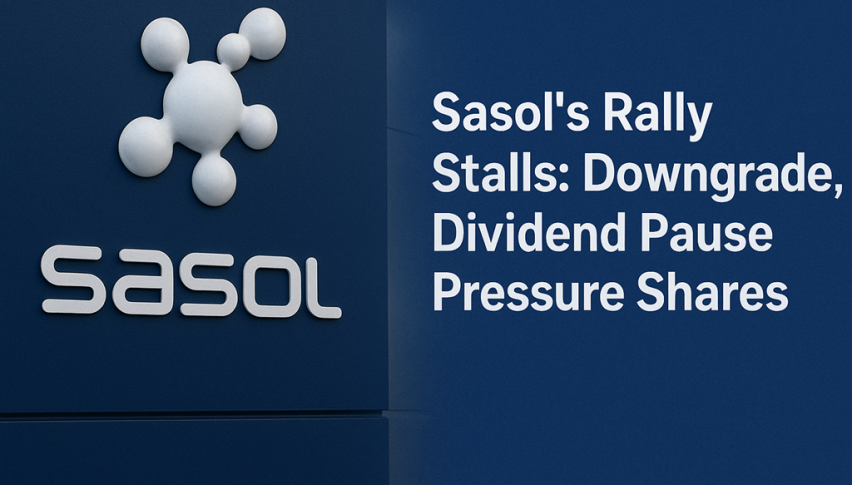Sasol Share Price JSE: SOL Retreats 18% Monthly, as Long-Term Downtrend Resumes, but There’s Hope
Sasol’s share price tumbled on Tuesday as renewed selling followed a Morgan Stanley downgrade, overshadowing signs of financial recovery...

Quick overview
- Sasol's share price fell 3.26% following a downgrade by Morgan Stanley, despite recent financial recovery signs.
- The company's fundamentals improved significantly, with headline earnings per share surging 93% year-over-year.
- Sasol's management is focused on structural improvements and debt reduction, prioritizing financial stability over dividends.
- Investors remain cautious as the stock tests key technical support levels amid concerns over long-term risks.
Sasol’s share price tumbled on Tuesday as renewed selling followed a Morgan Stanley downgrade, overshadowing signs of financial recovery and operational progress.
Sasol Shares Under Pressure After Downgrade
Sasol (JSE: SOL) led declines in the JSE Top 40 on Tuesday, falling 3.26% to close at R103, extending a broader monthly slide of nearly 18%. The pullback followed a downgrade by Morgan Stanley, which shifted its rating from Overweight to Equal Weight, citing concerns over long-term risks despite near-term improvements.
The company had staged an impressive rebound earlier this year, rallying from R55 in April to R127 in September—a gain of more than 100%—before sellers reasserted control. The reversal underscores investor caution as Sasol grapples with structural challenges despite earnings improvements.
Technical Picture: Rally Stalls at Key Resistance
The stock’s technical setup reflects the sharp shift in momentum. On the weekly chart, buyers failed to break above the 100-week SMA (green) in September, which acted as strong resistance and turned the trend lower.
SOLJ Chart Weekly – Buyers Will Likely Break the 100 SMA Too
Although the price has now retreated about 20% from September highs, Sasol recently broke above the 20-SMA (gray) and 50-SMA (yellow)—levels that had capped its price for years. Investors are watching whether these moving averages can act as support as the stock tests lower levels.
Financial Recovery Gains Traction
Despite the recent share price weakness, Sasol’s fundamentals have strengthened over the past year. For FY2025, headline earnings per share (HEPS) surged 93% YoY to R35.13, while basic EPS turned positive at R10.60 after a loss of R69.94 in FY2024.
This rebound was driven by:
- Improved free cash flow, up 75% to R12.6 billion after tax, capex, and interest.
- Debt reduction, with net debt down 13% to R64.96 billion.
- A one-off R4.3 billion settlement with Transnet that bolstered liquidity.
- Lower impairments and tighter cost controls, which offset weaker turnover and EBITDA.
Strategic Progress and Operational Focus
Sasol’s management emphasized ongoing structural improvements aligned with its Capital Markets Day 2025 commitments. Efforts to restore the Secunda Operations remain central, with the destoning facility on track to be fully operational by year-end.
While turnover fell 9% YoY to R249.1 billion and adjusted EBITDA dropped 14% to R51.8 billion, stronger cash generation and debt reduction underscored operational discipline.
Dividend Policy: Debt Takes Priority
Despite the earnings turnaround, Sasol withheld both interim and final dividends for FY2025, prioritizing further debt reduction to bring net debt below the $3 billion threshold.
Management noted that much of the debt progress in FY2025 stemmed from short-term factors—such as working capital unwind, dividend revenues, and the Transnet payment—raising questions about the sustainability of these gains.
Morgan Stanley highlighted that although refining margins offered temporary relief, longer-term risks could offset Sasol’s progress, reinforcing the cautious rating downgrade.
Outlook: Sasol’s recent price action signals renewed market skepticism despite notable financial improvements and operational milestones. Investors will closely monitor whether technical support holds near current levels and if management can sustain free cash flow growth while further reducing debt.
The stock’s near-term trajectory will likely hinge on progress at Secunda, stability in refining margins, and signs that Sasol’s turnaround efforts can translate into consistent shareholder returns.
- Check out our free forex signals
- Follow the top economic events on FX Leaders economic calendar
- Trade better, discover more Forex Trading Strategies
- Open a FREE Trading Account



